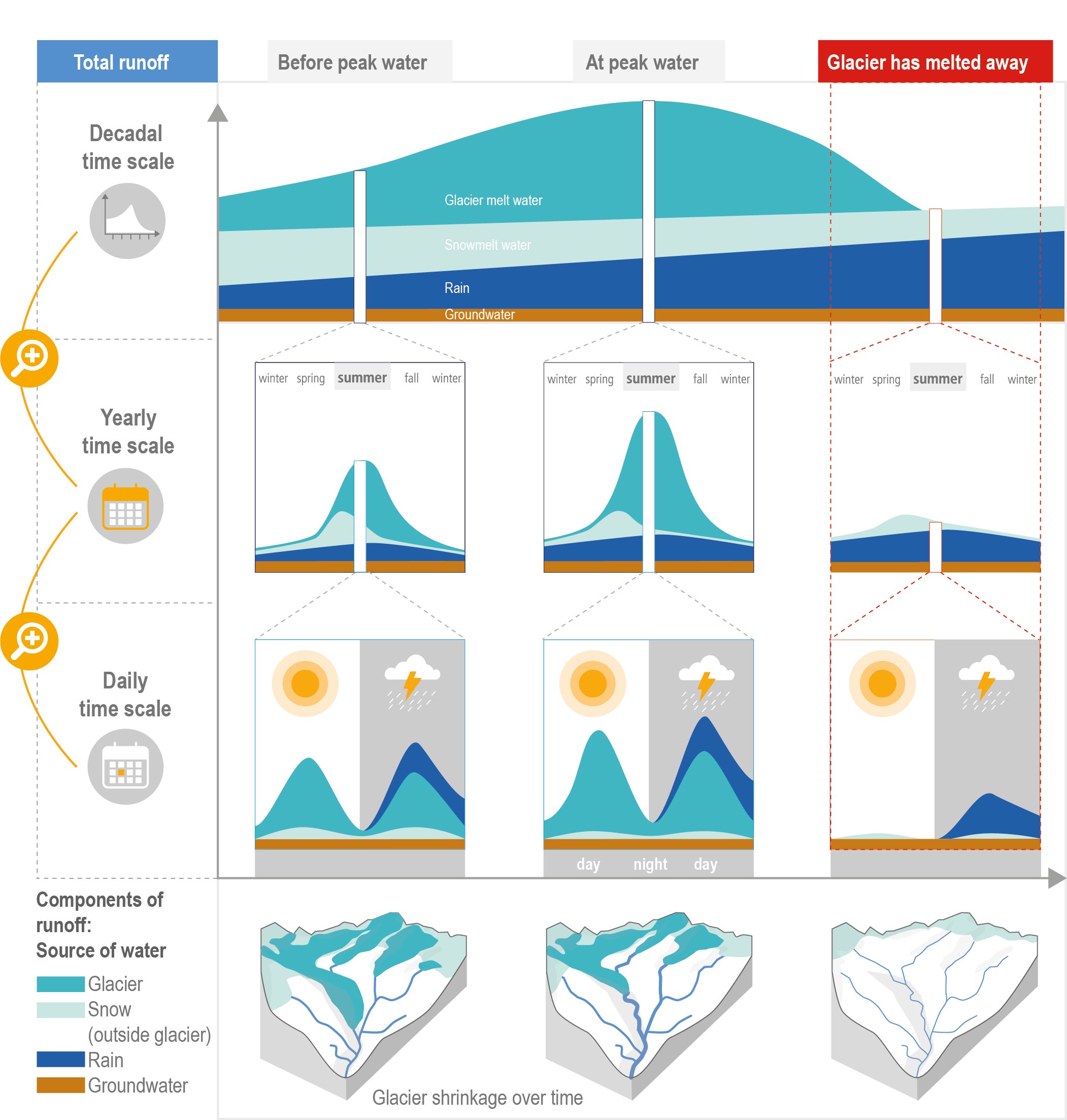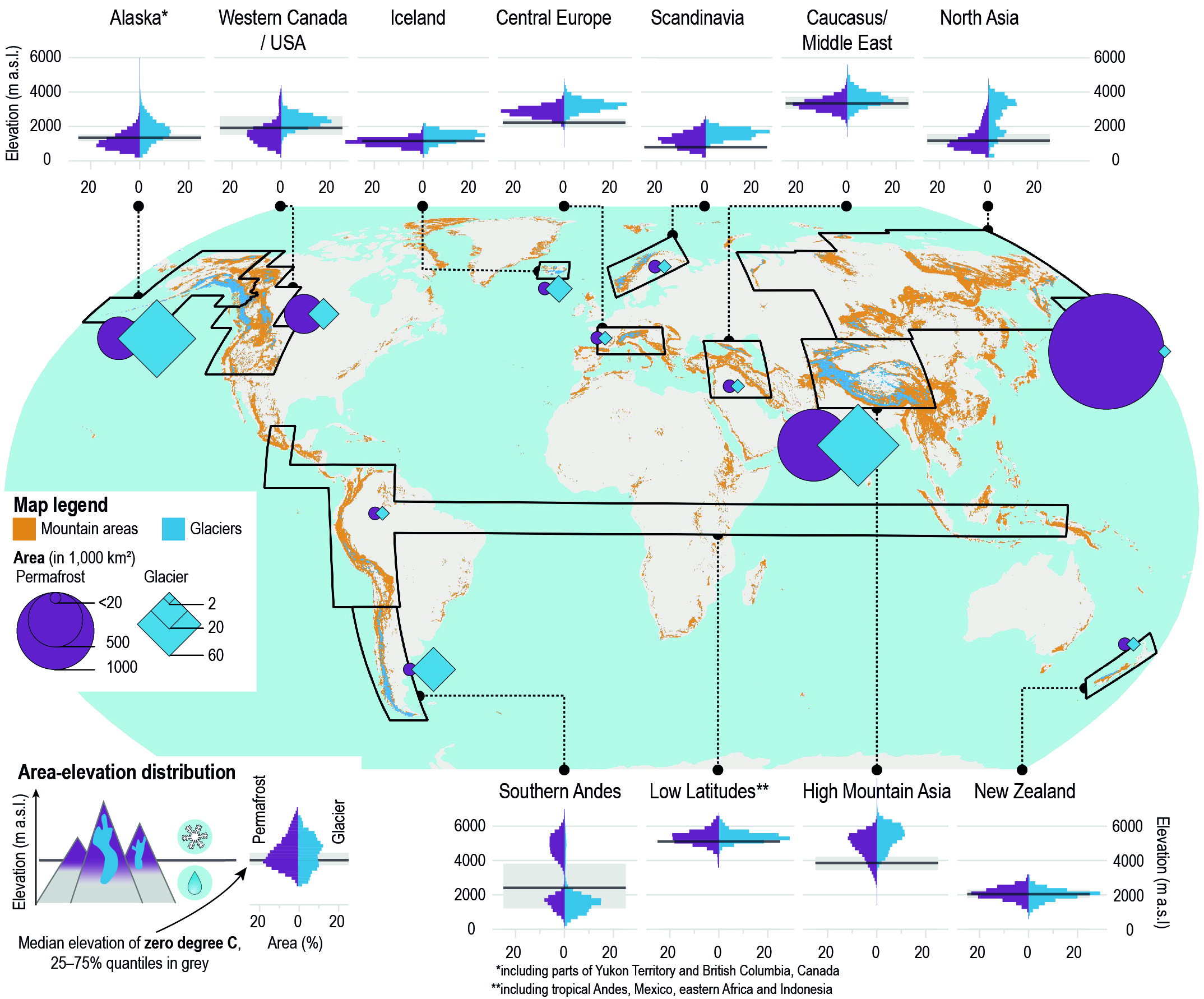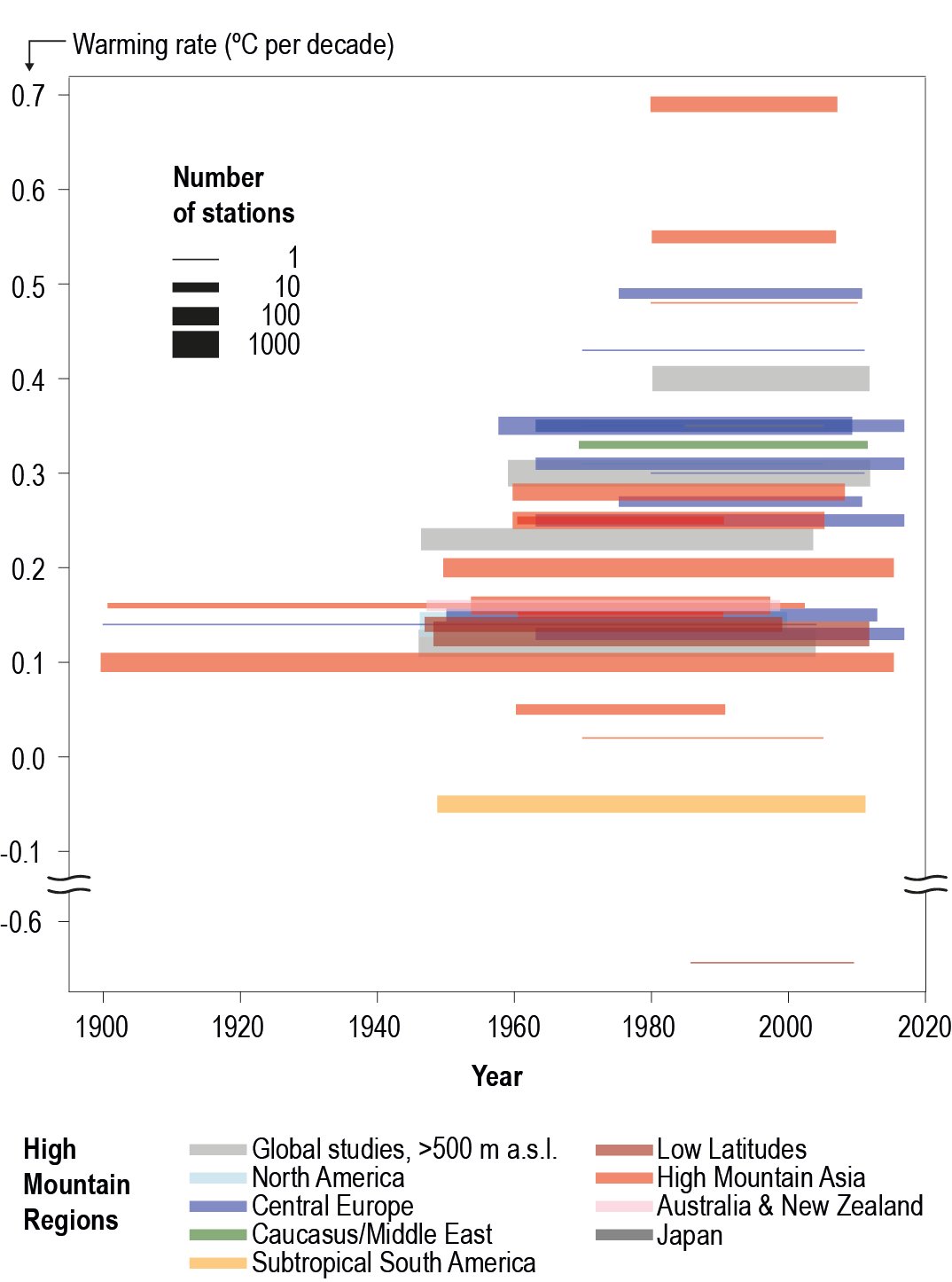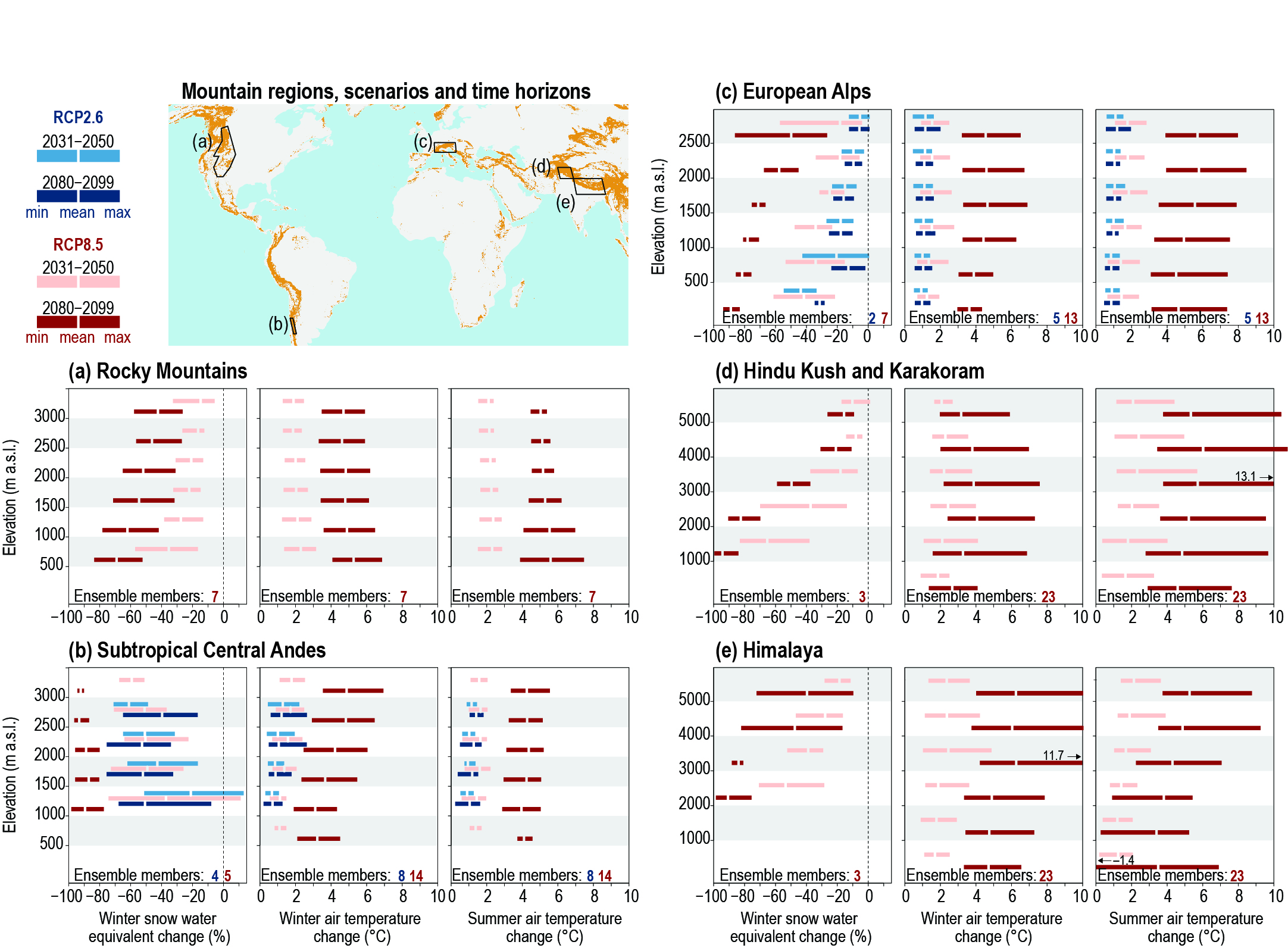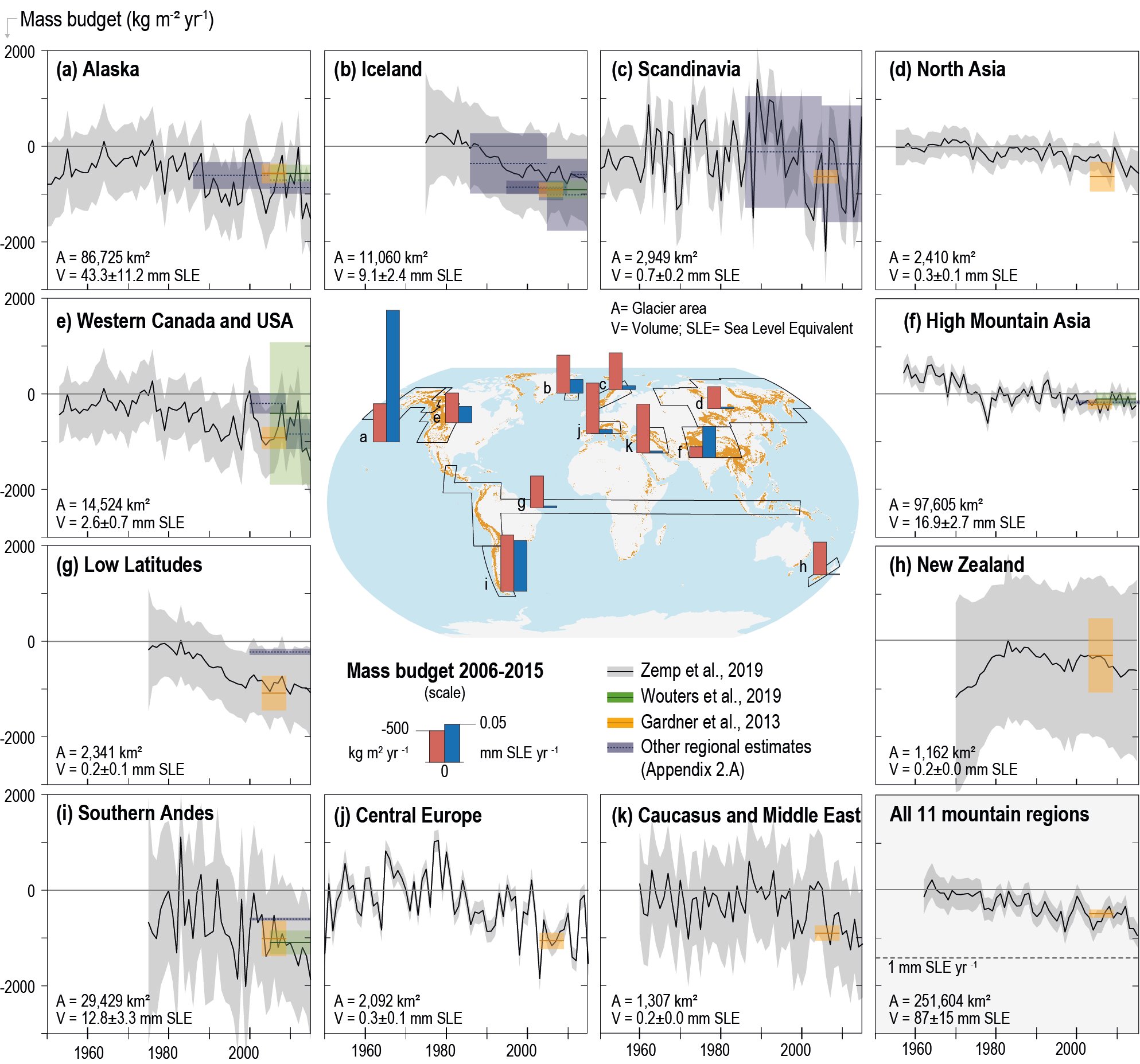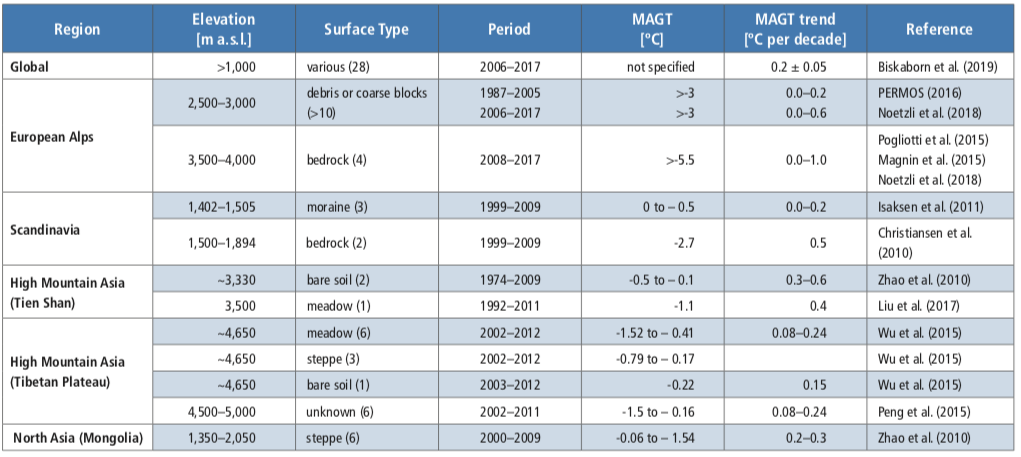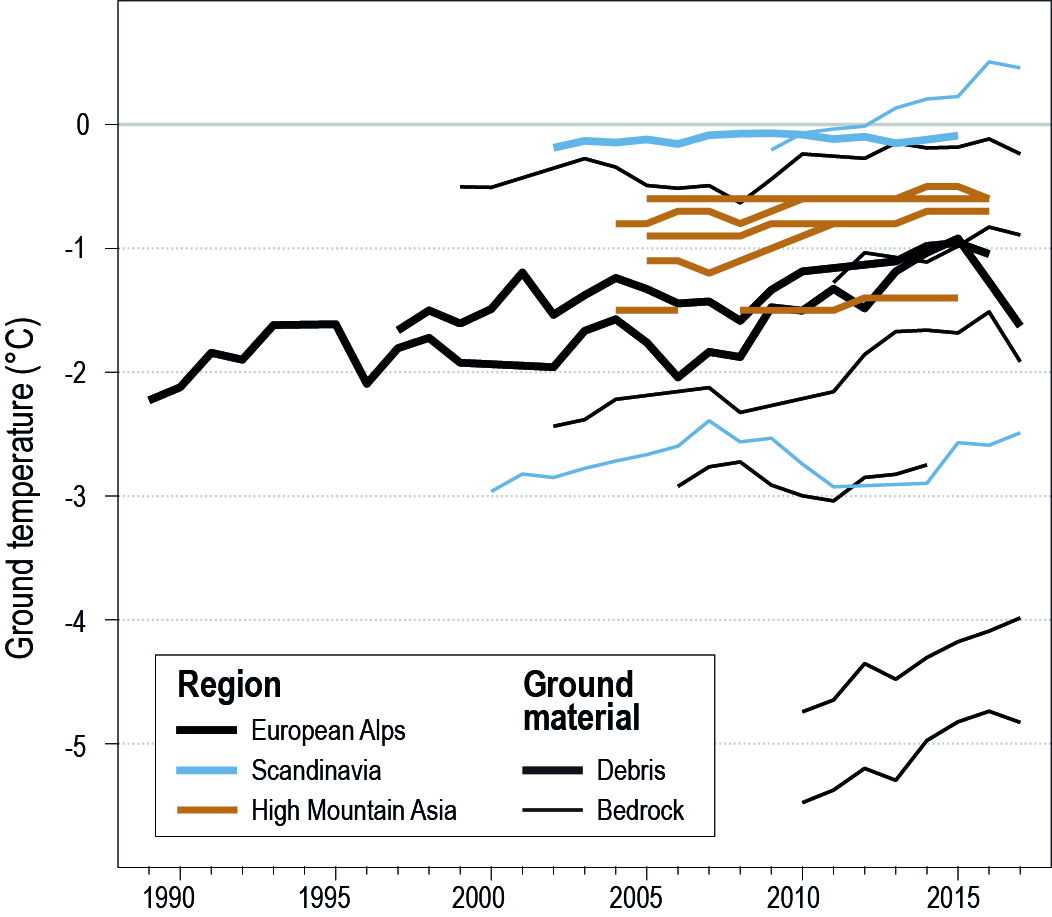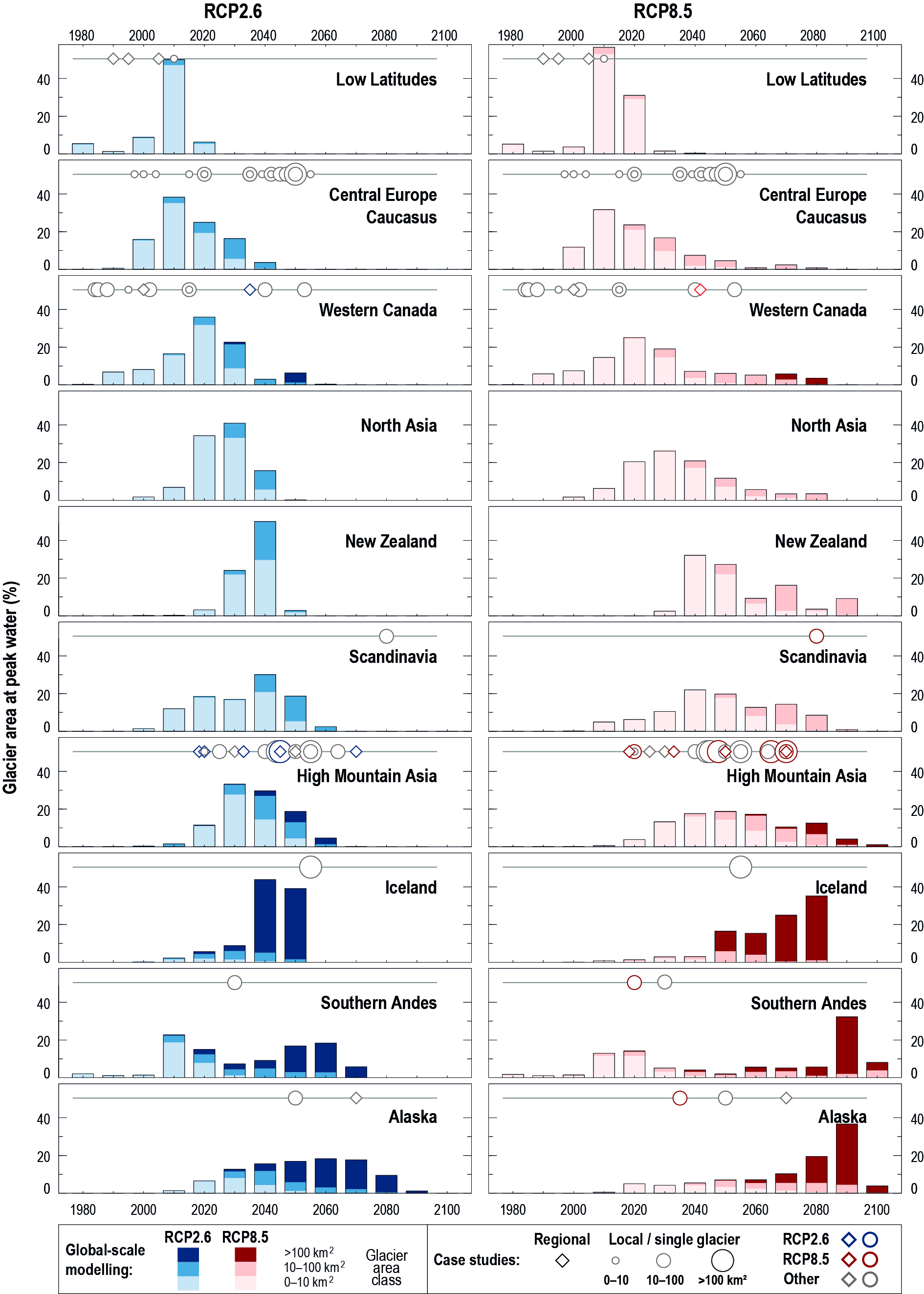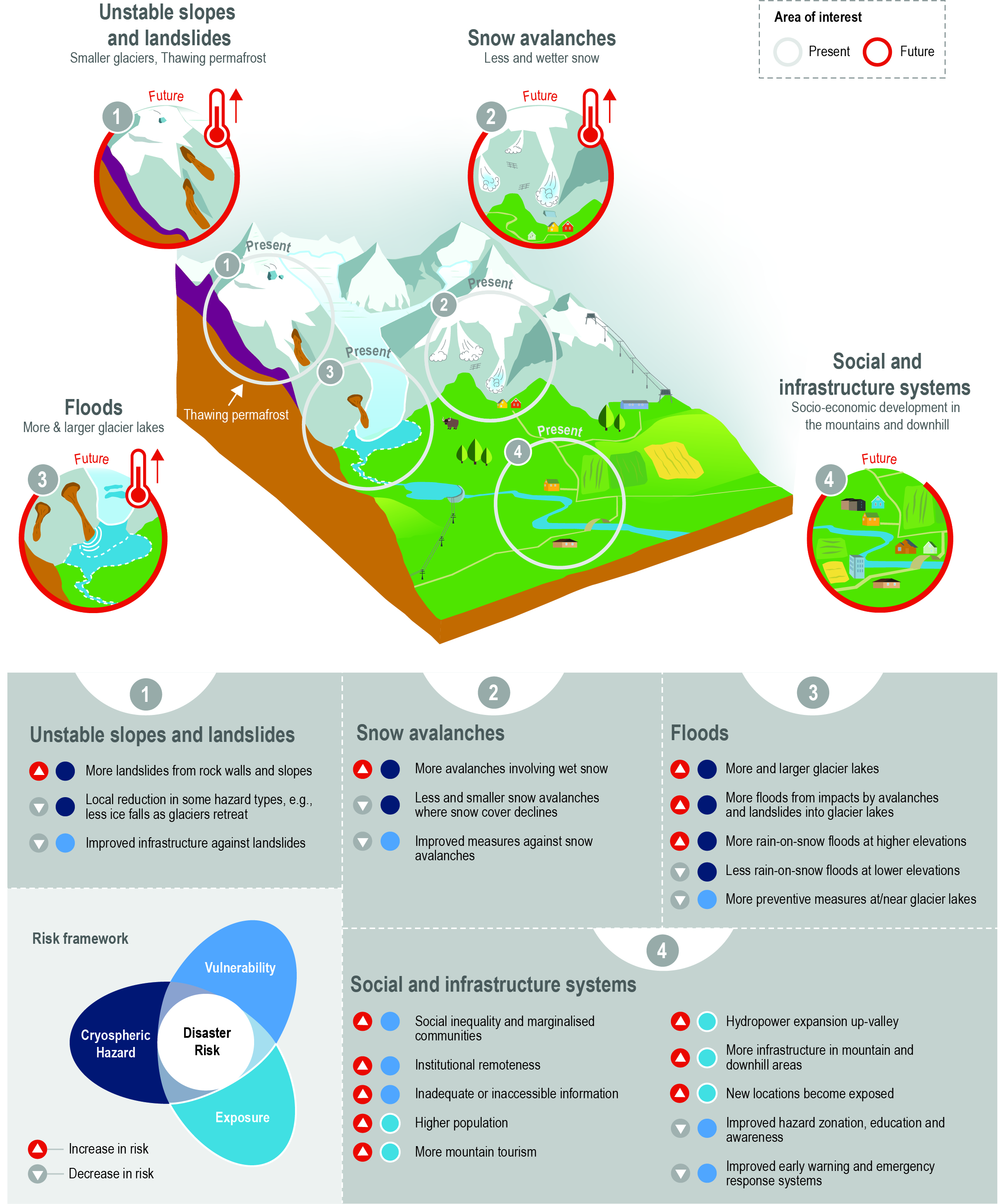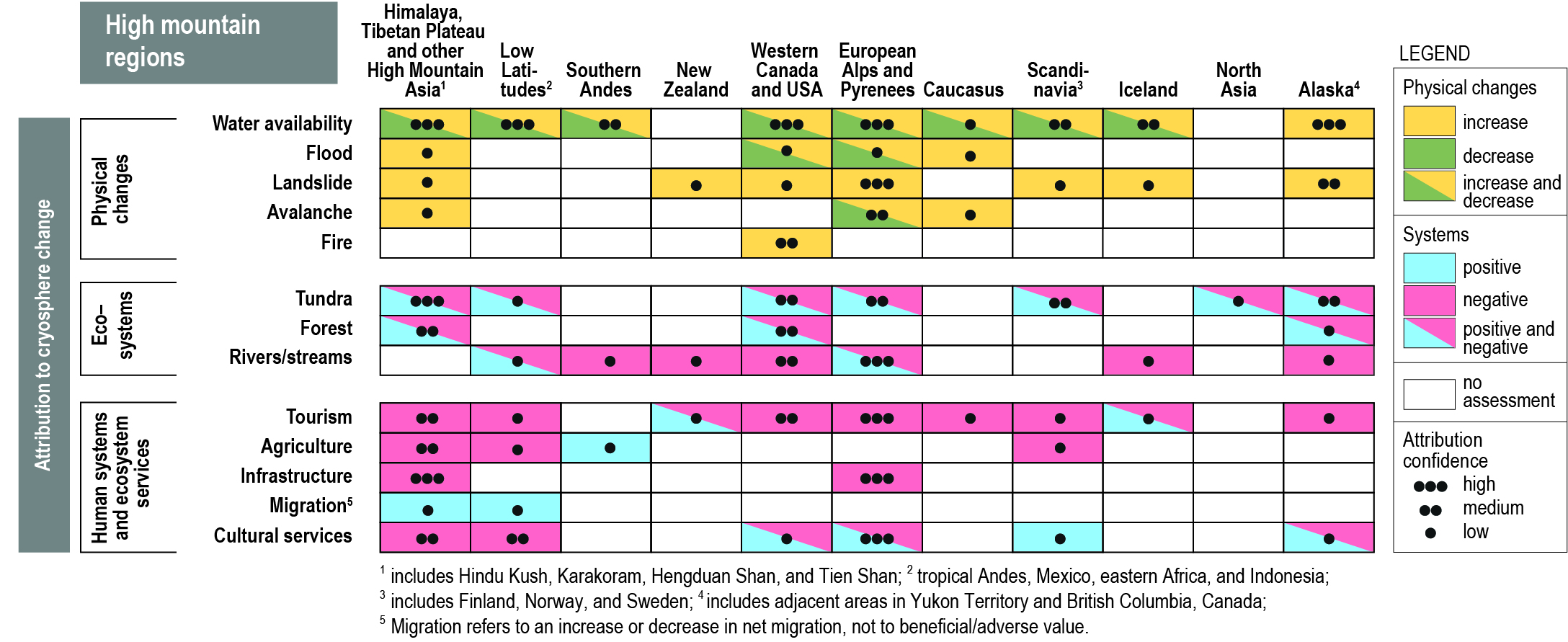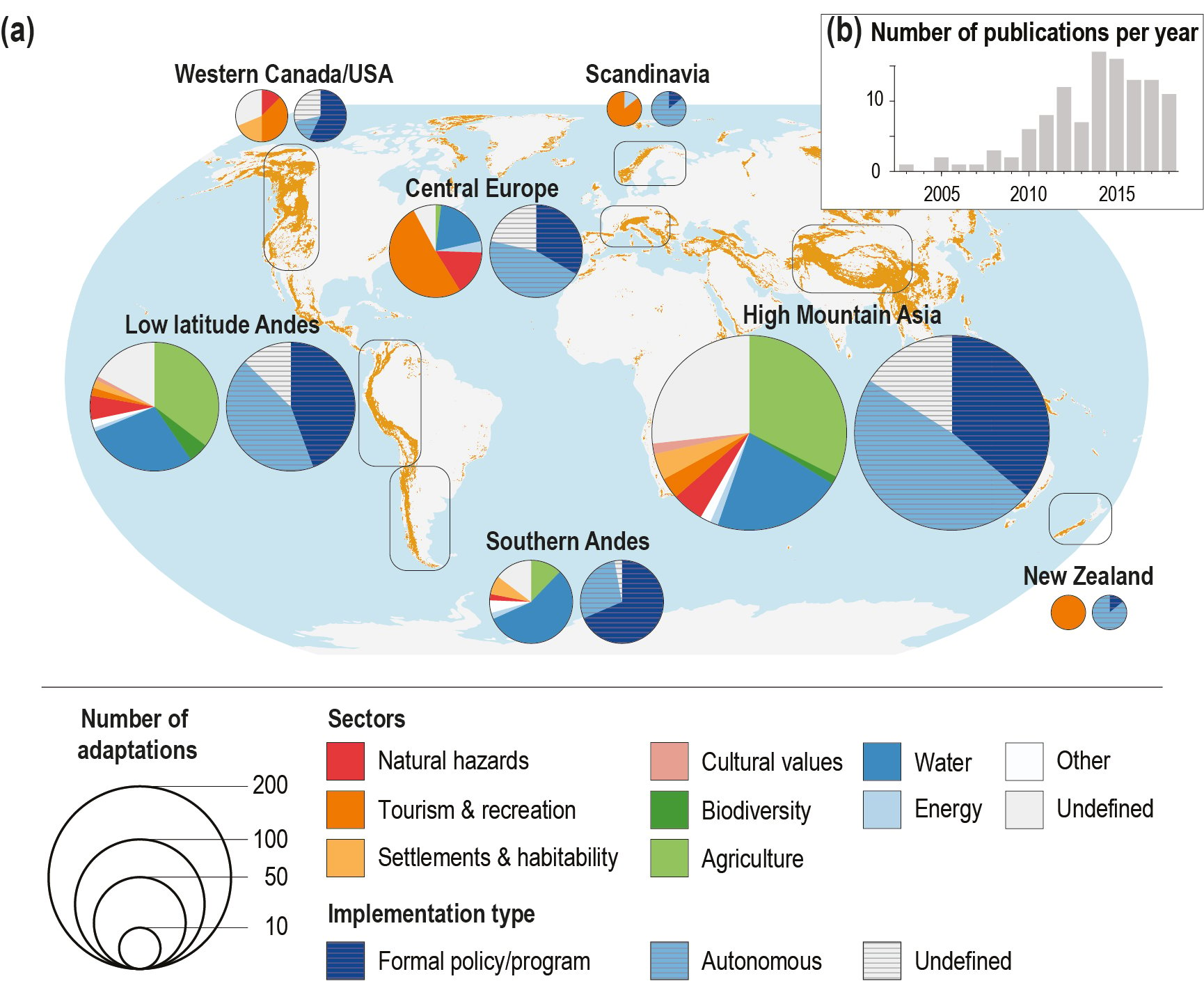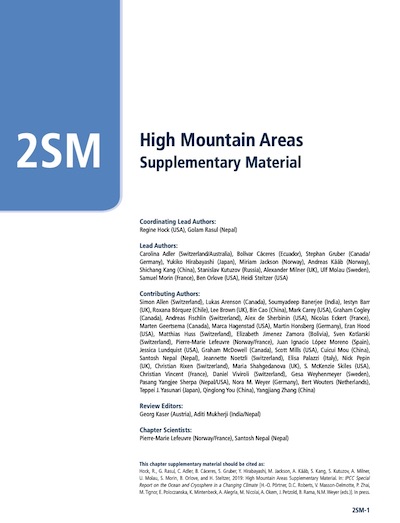ES
Executive Summary
The cryosphere (including, snow, glaciers, permafrost, lake and river ice) is an integral element of high mountain regions, which are home to roughly 10% of the global population. Widespread cryosphere changes affect physical, biological and human systems in the mountains and surrounding lowlands, with impacts evident even in the ocean. Building on the IPCC’s 5th Assessment Report (AR5), this chapter assesses new evidence on observed recent and projected changes in the mountain cryosphere as well as associated impacts, risks and adaptation measures related to natural and human systems. Impacts in response to climate changes independently of changes in the cryosphere are not assessed in this chapter. Polar mountains are included in Chapter 3, except those in Alaska and adjacent Yukon, Iceland and Scandinavia, which are included in this chapter.
Observations of cryospheric changes, impacts, and adaptation in high mountain areas
Observations show general decline in low-elevation snow cover (high confidence1), glaciers (very high confidence) and permafrost (high confidence) due to climate change in recent decades. Snow cover duration has declined in nearly all regions, especially at lower elevations, on average by 5 days per decade, with a likely2 range from 0–10 days per decade. Low elevation snow depth and extent have declined, although year-to-year variation is high. Mass change of glaciers in all mountain regions (excluding the Canadian and Russian Arctic, Svalbard, Greenland and Antarctica) was very likely -490 ± 100 kg m-2 yr-1 (-123 ± 24 Gt yr-1) in 2006–2015. Regionally averaged mass budgets were likely most negative (less than -850 kg m-2 yr-1) in the southern Andes, Caucasus and the European Alps/Pyrenees, and least negative in High Mountain Asia (-150 ± 110 kg m-2 yr-1) but variations within regions are strong. Between 3.6–5.2 million km2 are underlain by permafrost in the eleven high mountain regions covered in this chapter corresponding to 27–29% of the global permafrost area (medium confidence). Sparse and unevenly distributed measurements show an increase in permafrost temperature (high confidence), for example, by 0.19ºC ± 0.05ºC on average for about 28 locations in the European Alps, Scandinavia, Canada and Asia during the past decade. Other observations reveal decreasing permafrost thickness and loss of ice in the ground. {2.2.2, 2.2.3, 2.2.4}
Glacier, snow and permafrost decline has altered the frequency, magnitude and location of most related natural hazards (high confidence). Exposure of people and infrastructure to natural hazards has increased due to growing population, tourism and socioeconomic development (high confidence). Glacier retreat and permafrost thaw have decreased the stability of mountain slopes and the integrity of infrastructure (high confidence). The number and area of glacier lakes has increased in most regions in recent decades (high confidence), but there is only limited evidence that the frequency of glacier lake outburst floods (GLOF) has changed. In some regions, snow avalanches involving wet snow have increased (medium confidence), and rain-on-snow floods have decreased at low elevations in spring and increased at high elevations in winter (medium confidence). The number and extent of wildfires have increased in the Western USA partly due to early snowmelt (medium confidence). {2.3.2, 2.3.3}
Changes in snow and glaciers have changed the amount and seasonality of runoff in snow-dominated and glacier-fed river basins (very high confidence) with local impacts on water resources and agriculture (medium confidence). Winter runoff has increased in recent decades due to more precipitation falling as rain (high confidence). In some glacier-fed rivers, summer and annual runoff have increased due to intensified glacier melt, but decreased where glacier melt water has lessened as glacier area shrinks. Decreases were observed especially in regions dominated by small glaciers, such as the European Alps (medium confidence). Glacier retreat and snow cover changes have contributed to localized declines in agricultural yields in some high mountain regions, including the Hindu Kush Himalaya, and the tropical Andes (medium confidence). There is limited evidence of impacts on operation and productivity of hydropower facilities resulting from changes in seasonality and both increases and decreases in water input, for example, in the European Alps, Iceland, Western Canada and USA, and the tropical Andes. {2.3.1}
Species composition and abundance have markedly changed in high mountain ecosystems in recent decades (very high confidence), partly due to changes in the cryosphere (high confidence). Habitats for establishment by formerly absent species have opened up or been altered by reduced snow cover (high confidence), retreating glaciers (very high confidence), and thawing of permafrost (medium confidence). Reductions in glacier and snow cover have directly altered the structure of many freshwater communities (high confidence). Reduced snow cover has negatively impacted the reproductive fitness of some snow-dependent plant and animal species, including foraging and predator-prey relationships of mammals (high confidence). Upslope migration of individual species, mostly due to warming and to a lesser extent due to cryosphere-related changes, has often increased local species richness (very high confidence). Some cold-adapted species, including endemics, in terrestrial and freshwater communities have declined in abundance (high confidence). While the plant productivity has generally increased, the actual impact on provisioning, regulating and cultural ecosystem services varies greatly (high confidence). {2.3.3}
Tourism and recreation activities such as skiing, glacier tourism and mountaineering have been negatively impacted by declining snow cover, glaciers and permafrost (medium confidence). In several regions, worsening route safety has reduced mountaineering opportunities (medium confidence). Variability and decline in natural snow cover have compromised the operation of low-elevation ski resorts (high confidence). Glacier and snow decline have impacted aesthetic, spiritual and other cultural aspects of mountain landscapes (medium confidence), reducing the well-being of people (e.g., in the Himalaya, eastern Africa, and the tropical Andes). {2.3.5, 2.3.6}
Adaptation in agriculture, tourism and drinking water supply has aimed to reduce the impacts of cryosphere change (medium confidence), though there is limited evidence on their effectiveness owing to a lack of formal evaluations, or technical, financial and institutional barriers to implementation. In some places, artificial snowmaking has reduced the negative impacts on ski tourism (medium confidence). Release and storage of water from reservoirs according to sectoral needs (agriculture, drinking water, ecosystems) has reduced the impact of seasonal variability on runoff (medium confidence). {2.3.1, 2.3.5}
Future projections of cryospheric changes, their impacts and risks, and adaptation in high mountain areas
Snow cover, glaciers and permafrost are projected to continue to decline in almost all regions throughout the 21st century (high confidence). Compared to 1986–2005, low elevation snow depth will likely decrease by 10–40% for 2031–2050, regardless of Representative Concentration Pathway (RCP) and for 2081–2100, likely by 10–40 % for RCP2.6 and by 50–90% for RCP8.5. Projected glacier mass reductions between 2015–2100 are likely 22–44% for RCP2.6 and 37–57% for RCP8.5. In regions with mostly smaller glaciers and relatively little ice cover (e.g., European Alps, Pyrenees, Caucasus, North Asia, Scandinavia, tropical Andes, Mexico, eastern Africa and Indonesia), glaciers will lose more than 80% of their current mass by 2100 under RCP8.5 (medium confidence), and many glaciers will disappear regardless emission scenario (very high confidence). Permafrost thaw and degradation will increase during the 21st century (very high confidence) but quantitative projections are scarce. {2.2.2, 2.2.3}
Most types of natural hazards are projected to change in frequency, magnitude and areas affected as the cryosphere continues to decline (high confidence). Glacier retreat and permafrost thaw are projected to decrease the stability of mountain slopes and increase the number and area of glacier lakes (high confidence). Resulting landslides and floods, and cascading events, will also emerge where there is no record of previous events (high confidence). Snow avalanches are projected to decline in number and runout distance at lower elevation, and avalanches involving wet snow even in winter will occur more frequently (medium confidence). Rain-on-snow floods will occur earlier in spring and later in autumn, and be more frequent at higher elevations and less frequent at lower elevations (high confidence). {2.3.2, 2.3.3}
River runoff in snow dominated and glacier-fed river basins will change further in amount and seasonality in response to projected snow cover and glacier decline (very high confidence) with negative impacts on agriculture, hydropower and water quality in some regions (medium confidence). The average winter snowmelt runoff is projected to increase (high confidence), and spring peaks to occur earlier (very high confidence). Projected trends in annual runoff vary substantially among regions, and can even be opposite in direction, but there is high confidence that in all regions average annual runoff from glaciers will have reached a peak that will be followed by declining runoff at the latest by the end of the 21st century. Declining runoff is expected to reduce the productivity of irrigated agriculture in some regions (medium confidence). Hydropower operations will increasingly be impacted by altered amount and seasonality of water supply from snow and glacier melt (high confidence). The release of heavy metals, particularly mercury, and other legacy contaminants currently stored in glaciers and permafrost, is projected to reduce water quality for freshwater biota, household use and irrigation (medium confidence). {2.3.1}
Current trends in cryosphere-related changes in high mountain ecosystems are expected to continue and impacts to intensify (very high confidence). While high mountains will provide new and greater habitat area, including refugia for lowland species, both range expansion and shrinkage are projected, and at high elevations this will lead to population declines (high confidence). The latter increases the risk of local extinctions, in particular for freshwater cold-adapted species (medium confidence). Without genetic plasticity and/or behavioural shifts, cryospheric changes will continue to negatively impact endemic and native species, such as some coldwater fish (e.g., trout) and species whose traits directly depend on snow (e.g., snowshoe hares) or many large mammals (medium confidence). The survival of such species will depend on appropriate conservation and adaptation measures (medium confidence). Many projected ecological changes will alter ecosystem services (high confidence), affecting ecological disturbances (e.g., fire, rock fall, slope erosion) with considerable impacts on people (medium confidence). {2.3.3}
Cultural assets, such as snow- and ice-covered peaks in many UNESCO World Heritage sites, and tourism and recreation activities, are expected to be negatively affected by future cryospheric change in many regions (high confidence). Current snowmaking technologies are projected to be less effective in a warmer climate in reducing risks to ski tourism in most parts of Europe, North America and Japan, in particular at 2°C global warming and beyond (high confidence). Diversification through year-round activities supports adaptation of tourism under future climate change (medium confidence). {2.3.5, 2.3.6}
Enablers and response options to promote adaptation and sustainable development in high mountain areas
The already committed and unavoidable climate change affecting all cryosphere elements, irrespective of the emission scenario, points to integrated adaptation planning to support and enhance water availability, access, and management (medium confidence). Integrated management approaches for water across all scales, in particular for energy, agriculture, ecosystems and drinking water supply, can be effective at dealing with impacts from changes in the cryosphere. These approaches also offer opportunities to support social-ecological systems, through the development and optimisation of storage and the release of water from reservoirs (medium confidence), while being cognisant of potential negative implications for some ecosystems. Success in implementing such management options depends on the participation of relevant stakeholders, including affected communities, diverse knowledge and adequate tools for monitoring and projecting future conditions, and financial and institutional resources to support planning and implementation (medium confidence). {2.3.1, 2.3.3, 2.4}
Effective governance is a key enabler for reducing disaster risk, considering relevant exposure factors such as planning, zoning, and urbanisation pressures, as well as vulnerability factors such as poverty, which can challenge efforts towards resilience and sustainable development for communities (medium confidence). Reducing losses to disasters depend on integrated and coordinated approaches to account for the hazards concerned, the degree of exposure, and existing vulnerabilities. Diverse knowledge that includes community and multi-stakeholder experience with past impacts complements scientific knowledge to anticipate future risks. {CCB-1, 2.3.2, 2.4}
International cooperation, treaties and conventions exist for some mountain regions and transboundary river basins with potential to support adaptation action. However, there is limited evidence on the extent to which impacts and losses arising from changes in the cryosphere are specifically monitored and addressed in these frameworks. A wide range of institutional arrangements and practices have emerged over the past three decades that respond to a shared global mountain agenda and specific regional priorities. There is potential to strengthen them to also respond to climate-related cryosphere risks and open opportunities for development through adaptation (limited evidence, high agreement). The Sustainable Development Goals (SDGs), Sendai Framework and Paris Agreement have directed some attention in mountain-specific research and practice towards the monitoring and reporting on targets and indicators specified therein. {2.3.1, 2.4}
